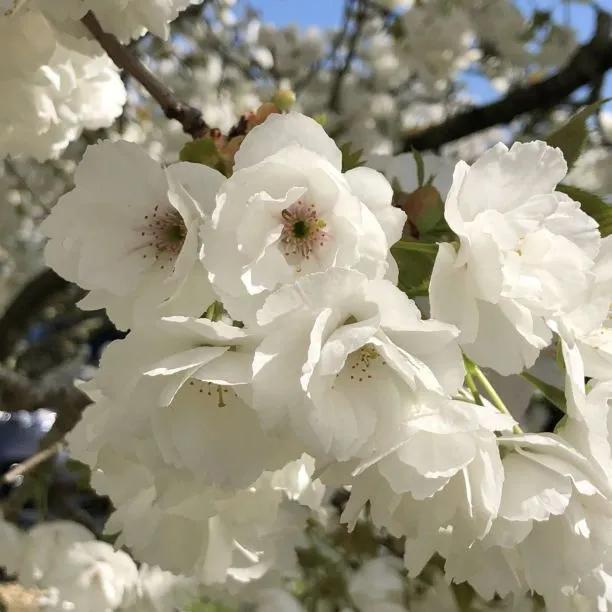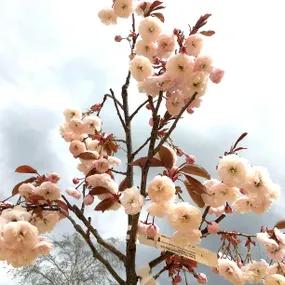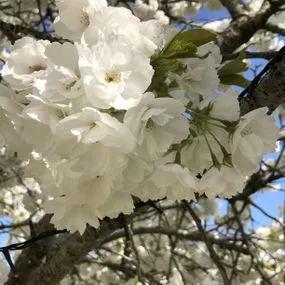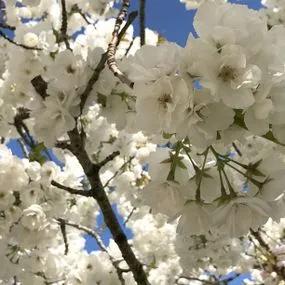Shirotae Cherry, Large Trees
The details
- Final height/spread: 6m x 6m
- Foliage: deciduous, amber autumn leaves,
- Use: specimen
- Features: scented white spring blossom, great spreading shape
- Soil: well drained
- RHS Award of Garden Merit
Recommended extras
Description
Prunus Shirotae: Bareroot Mount Fuji Cherry Trees in Standard Sizes
If you only have room for one cherry blossom tree, Prunus Shirotae, the Mount Fuji cherry is a top pick. The white semi-double spring blossom is some of the earliest to appear, beautifully scented, and contrasts well with the dark, striated bark.
The elegant serrated leaves, which appear after the blossom, turn from green to yellow, then a warm, fiery orange in autumn. In winter, its wide spreading shape and flat crown is a fine architectural feature. In short, it looks fabulous all year round!
Perfect for almost any sized garden, it grows to about 4m tall and about 6 wide: the largest one we know of is almost 10 metres wide.
Browse our other flowering cherry trees or all of our garden trees.
Delivery season: Cherry blossom trees are delivered bareroot during late autumn and winter, approximately November-March inclusive.
Choosing a size: Small trees are cheaper, easier to handle and more forgiving of less than ideal aftercare, so they are best for a big planting project. If instant impact is your priority, or if you are only buying a few plants for use in a place where it is convenient to water them well in their first year, then you may as well use bigger ones. All our bareroot trees are measured by their height in centimetres above the ground (the roots aren't measured).
Features:
- Height: 4-6m, spreading wider than it is tall with age
- Soil: Any well drained
- Use: Specimen, small garden, large container, avenue, urban
- Colour: White
- RHS Award of Garden Merit
- Bareroot delivery only: November-March
Growing Shirotae Cherry Trees
Any well drained soil. Suitable for large containers designed for trees. Full sun or partial shade. Tolerates moderate urban pollution.
Shirotae looks best with space to shine while blossoming, so make sure it's planted as a focal point, ideally with one of those famously vivid blue British spring skies as a backdrop. Avoid areas near paths and parking spaces as the branches can be pretty low, often reaching to the ground when mature.
A few spring bulbs planted around the base like crocuses, muscari, or a quietly lovely daffodil such as Hawera are a superb addition.
Planting Instructions
Notes on planting Prunus Shirotae:
Shirotae (Mount Fuji cherries) prefer fertile, moist soil with good drainage. They like heavy clay, as long as the site doesn't become waterlogged in winter. They are good to grow on chalky soil. Although your trees are hardy, late spring frosts can ruin their flower display. Avoid planting cherry blossom trees in frost pockets or North facing sites in colder areas.
Prepare your site before planting:
It is good to dig over the site where you plant a tree several months in advance. Kill the weeds first: for tough weeds like nettles, brambles and ground elder, you will usually need a weed-killer to get rid of them. When you dig the soil over, remove stones and other rubbish and mix in well-rotted compost or manure down to the depth of about 2 spades.
Watch our video on how to plant a tree for full instructions.
Remember to water establishing trees during dry weather for at least a year after planting.
Tree Planting accessories:
Prepare your site for planting by killing the weeds and grass. You can buy a tree planting pack with a wooden stake & rubber tie to support the tree and a mulch mat with pegs to protect the soil around the base of your tree from weeds and drying out. We suggest that you use mycorrhizal "friendly fungi" on the roots of all newly planted large trees: if your soil quality is poor, we strongly recommend it.
After you plant a tree, the most important thing to do is water it in dry weather. You will also need to weed around the plants. Watering should be thorough, so the ground is soaked. Let the soil almost dry out before watering again. Watering & weeding will be necessary for at least a year after planting.
Shirotae trees benefit from a little tidying up when they are mature. Remove spindly side branches and stems that flower poorly every few years.
If your trees do need pruning, it is necessary to do this in summer to avoid the risk of silver leaf disease. Always hire a tree surgeon to remove large branches.
Special notes on caring for Prunus Shirofugen:
Prunus Shirofugen Cherry is an ornamental tree that will perform best when it receives a yearly mulch of well-rotted manure or compost to help keep the soil around it fertile.
Remember to check the stake and tie supporting your trees a few times a year. Tighten the tie if it becomes loose and loosen it as the tree grows. Make sure that the tree's trunk isn't rubbing against the stake.
Hygiene & Diseases:
Dead, damaged or diseased wood can be pruned off as soon as it appears.
Disinfect your pruning tools between every cut if there is any sign of disease.
Burn or dispose of any diseased material, do not compost it.
Did You Know?
Shirotae is a fine, snow-white cloth made from the bark of the paper mulberry. The tree is also known as Mount Fuji, the most famous of Japan's three holy mountains, which is capped with snow for half the year.
It was introduced to Britain in the early 1900s.
Standard trees are measured by their girth in centimetres 1 metre above ground level: their trunk's waist measurement. Unlike sapling trees and hedge plants, standards aren't measured by their height, which will vary quite a bit both between and within species.
So, a 6/8cm standard tree has a trunk with a circumference of 6-8cm and an 8/10 standard has a trunk 8-10cm around. This measurement makes no difference to the tree's final height.
On average, standard trees are 2-3.5 metres tall when they arrive, but we cannot tell you precisely how tall your trees will be before we deliver them.





